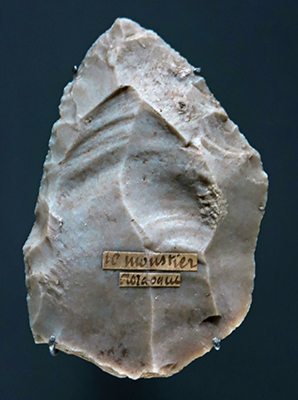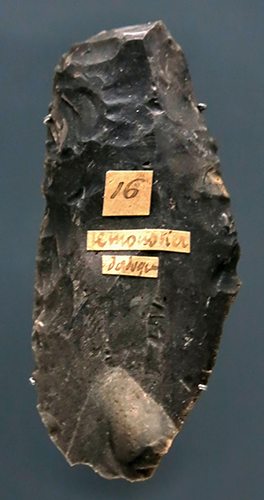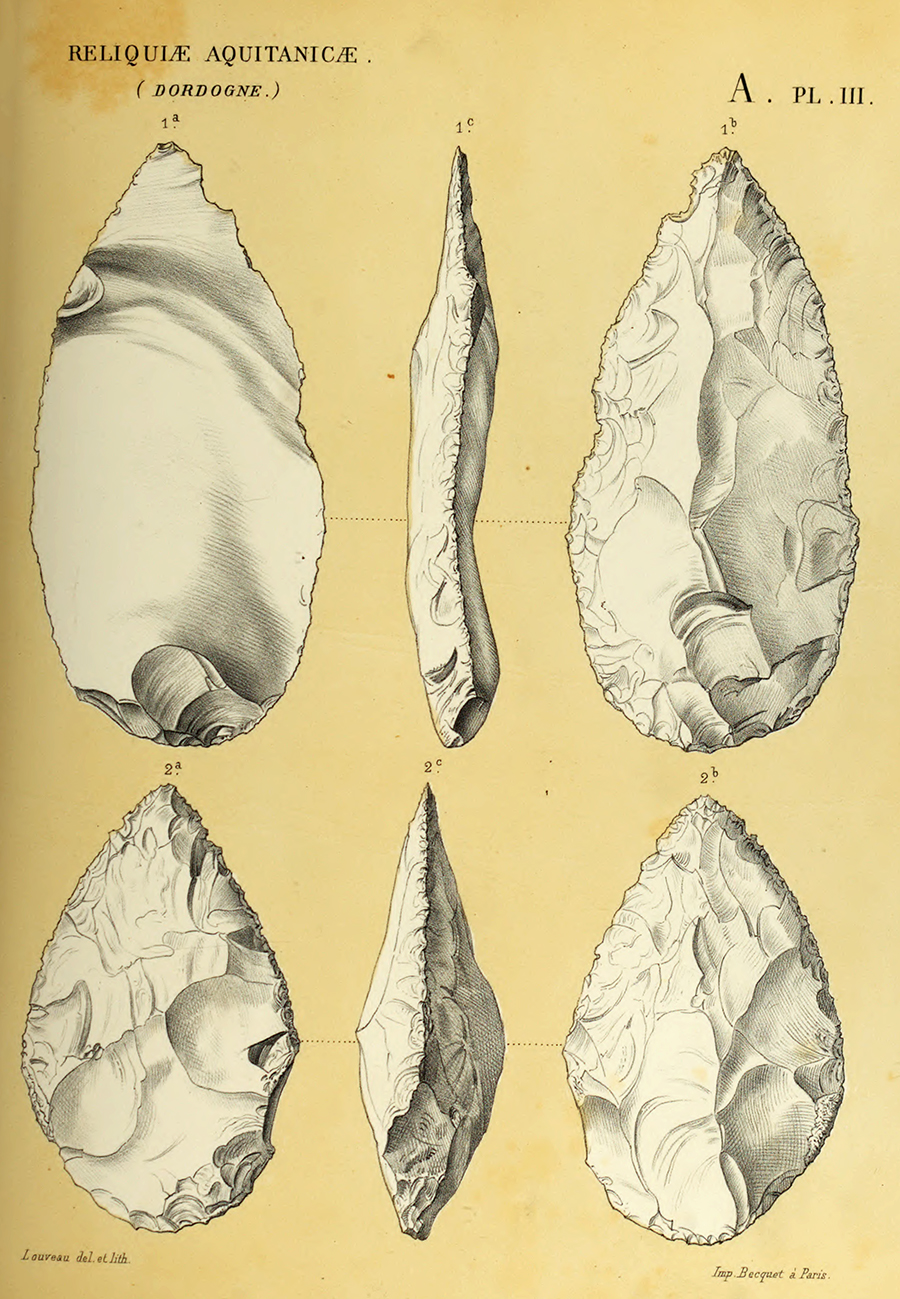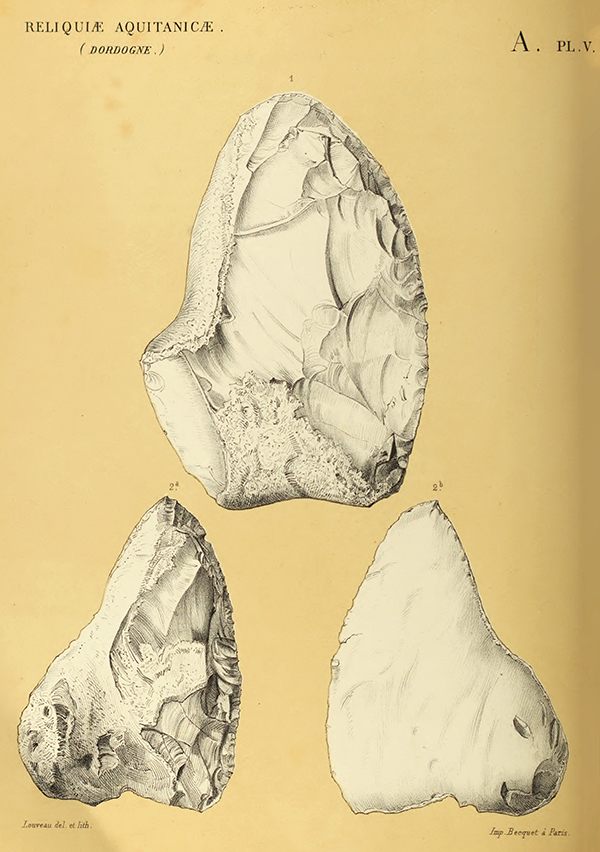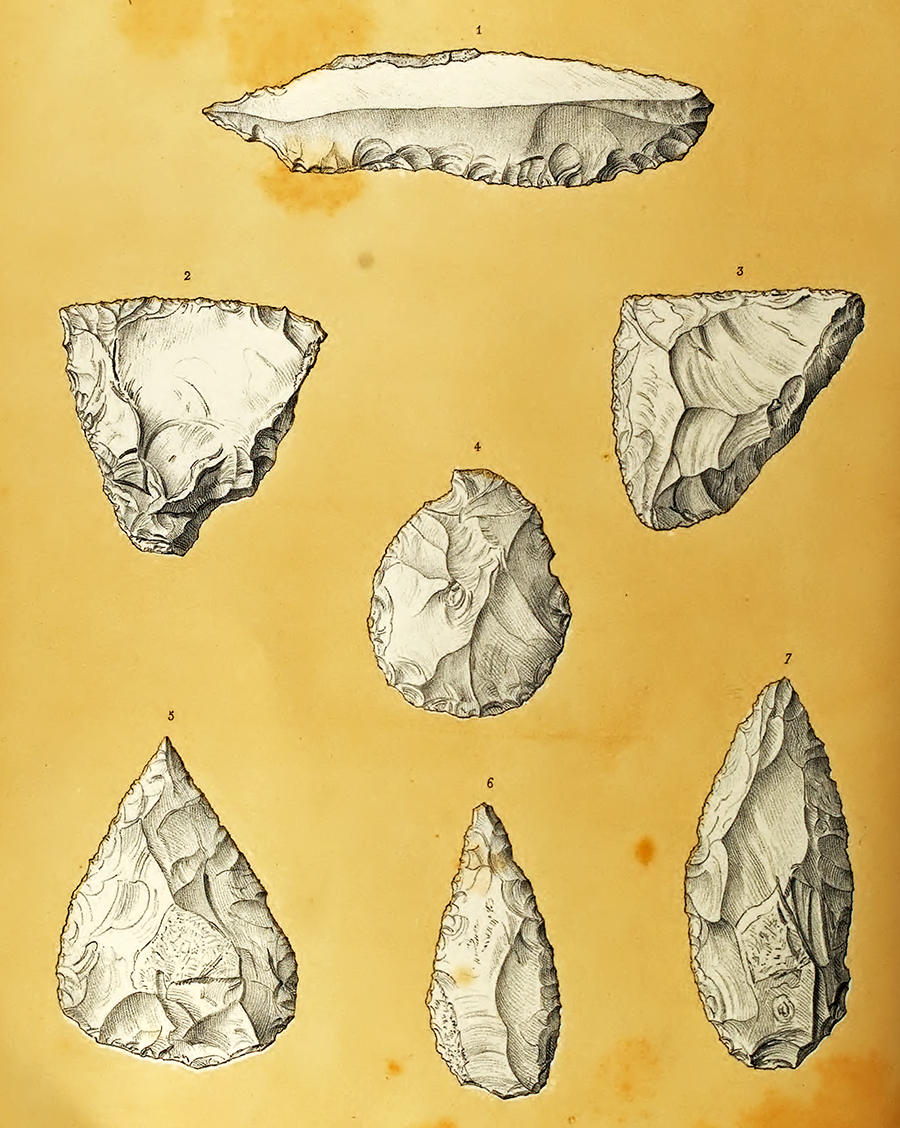Back to Don's Maps
 Back to Archaeological Sites
Back to Archaeological Sites
 Back to the review of hominins
Back to the review of hominins
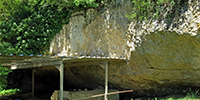 Back to the Le Moustier site
Back to the Le Moustier site
Le Moustier Tools
Le Moustier, racloirs, side scrapers.
Age circa 55 000 BP.
Collection M. Bourlon
Photo: Don Hitchcock 2015
Source and text: Original, Muséum de Toulouse
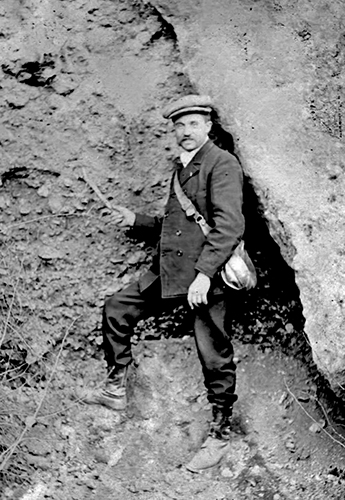
Maurice Bourlon, prehistorian, in 1911, at Laugerie-Basse.
Born in Bourges in 1875, from a landowner father, Maurice Bourlon enlisted in the army in 1894.
He died in combat at Higny in Meurthe-et-Moselle, on August 21, 1914.
Captain Bourlon was a remarkable prehistorian. Passionate about prehistory, he came to Les Eyzies a few years ago to seek help, advice and direction from Peyrony . He had set to work with unparalleled ardor. At Moustier , at Laugerie-Basse , in the Beune valley, he made very interesting excavations. He had the merit of clearly recognizing and demonstrating the existence of the clearest Magdalenian in Orleans.Text above: Capitan (1915)
At Laugerie-Basse, I remember seeing him, deep in the shelter, rummaging in the dark, with his feet in the water, and examining the heaps of debris left by the old diggers. He found there a quantity of curious tools and above all three beautiful engravings on limestone slab. One especially is an admirable representation of a bison.
Bourlon was full of enthusiasm, full of activity. As soon as he had a few moments of freedom, he arrived in the Dordogne and began to search relentlessly. He was a gay and charming friend, a prehistorian by heart and race, both expert practitioner and good theoretician. It is a real loss for French prehistory. We send him a last and very sad farewell.
Photo: Unknown. This is a scan of a photo made available by the grandson of M. Bourlon, and published with his permission.
Source: The Bourlon family
Permission: This image is in the public domain
Text: Capitan (1915)
Additional text: Wikipedia
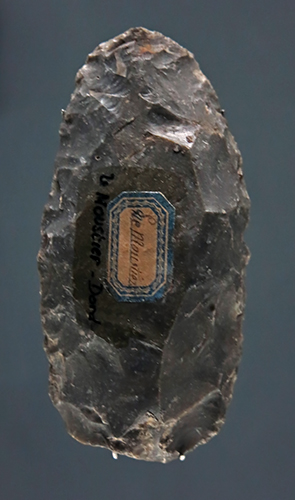
Le Moustier, racloir, side scraper.
Age circa 55 000 BP.
Photo: Don Hitchcock 2015
Source and text: Original, Muséum de Toulouse
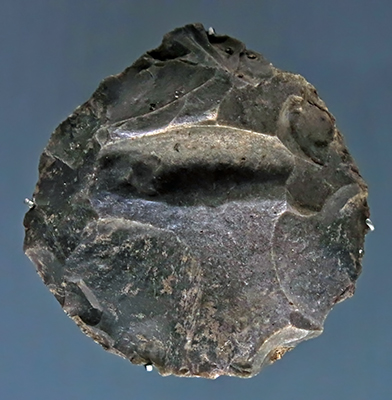
Le Moustier, Levallois core.
Collection of Jean-Baptiste Noulet.
Photo: Don Hitchcock 2015
Source and text: Original, Muséum de Toulouse
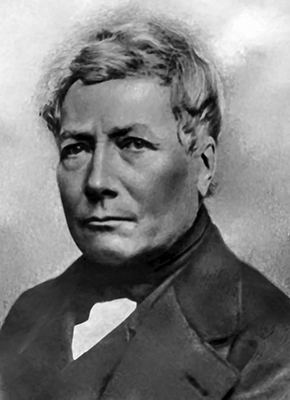
French naturalist Jean-Baptiste Noulet
Jean-Baptiste Noulet (1 May 1802 – 24 May 1890) was a French scientist and naturalist who helped to prove the archaeological existence of humans and was one of the pioneers of the scientific discipline of prehistoric archaeology. He was born in Venerque.
In 1851, at Clermont-le-Fort, he discovered the remains of Pleistocene fauna, along with the presence of lithic artefacts, findings that proved the co-existence of Pleistocene animals with humans, and in essence, confirmed ideas that were earlier proposed by prehistorian Jacques Boucher de Perthes.
Photo: Didier Descouens, 2010
Permission: Creative Commons Attribution-Share Alike 4.0 International license
Source: Muséum de Toulouse
Text and proximal source: Wikipedia
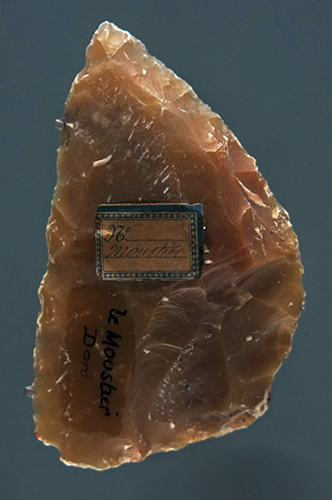
Racloir, side scraper, emblematic of the Mousterian.
This particular racloir has both an arched and a straight working surface.
Photo: Don Hitchcock 2015
Collection: É. Cartailhac
Source: Original, Muséum de Toulouse
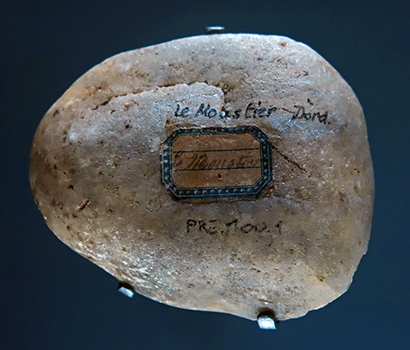
Percuteur, hammer stone.
( This is obviously a 'found' tool, with no need for further modification. In cases like this, the collector must decide whether it was used as a tool or if it is simply a random piece of rock. It may be put in the category of tool by considering wear or damage marks on the stone, and whether it is out of context, that is, in an archaeological layer, and whether it is quite different to the 'country rock'. In this case, there would probably be damage at the percussion end, and it was found in an archaeological layer without similar rocks of natural origin.
I can picture the artisan at the edge of the Vézère, spying this rock at its edge, picking it up, and deciding that it was perfect for the job - Don )
Photo: Don Hitchcock 2015
Collection: É. Cartailhac
Source: Original, Muséum de Toulouse

Émile Cartailhac was born at Camarès in 1844, and for more than fifty years was one of the dominant figures in the study of prehistoric archaeology in France. He settled early at Toulouse, and founded there in 1866 à museum of human palaeontology. His success as a lecturer was immediate, and eventually led to his appointment as professor of prehistoric archaeology, the only appointment of the kind in France at that time.
Photo: Unknown, studio photograph
Proximal source: https://archeologie.culture.fr/
Text: Adapted from https://www.nature.com/articles/109147a0
Percuteur.
( In marked contrast to the found percuteur above, this one has been extensively modified for the purpose. It would have been used on larger cores, where more leverage and impact was required - Don )
Photo: Don Hitchcock 2015
Collection: É. Lartet
Source: Original, Muséum de Toulouse
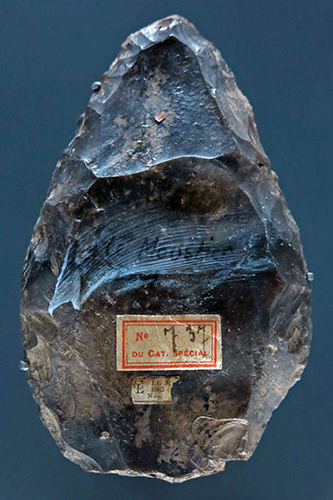
Biface, hand axe.
Photo: Don Hitchcock 2015
Collection: É. Lartet
Source: Original, Muséum de Toulouse

Le Moustier, layer G, excavations of D. Peyrony.
Age circa 55 000 BP.
■1 Bifaces, hand axes
■ 2 Racloirs, side scrapers
Photo: Don Hitchcock 2014
Source: Originals, Le Musée National de Préhistoire, Les Eyzies-de-Tayac

Le Moustier, layer G, excavations of D. Peyrony.
Age circa 55 000 BP.
■1 Bifaces, hand axes
■ 2 Racloirs, side scrapers
■ 3 Encoches/denticulés, notched/serrated tools
Photo: Don Hitchcock 2014
Source: Originals, Le Musée National de Préhistoire, Les Eyzies-de-Tayac
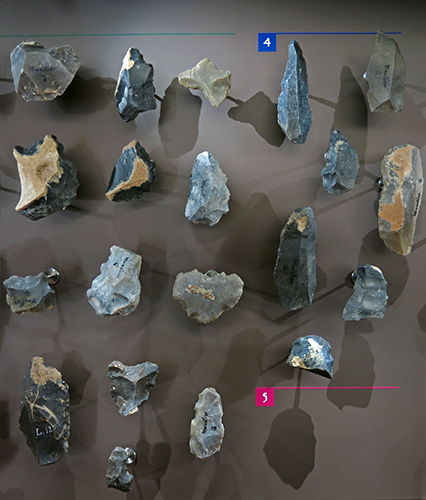
Le Moustier, layer G, excavations of D. Peyrony.
Age circa 55 000 BP.
■ 3 Encoches/denticulés, notched/serrated tools
■ 4 Tools of the upper Palaeolithic type
■ 5 Special tools
Photo: Don Hitchcock 2014
Source: Originals, Le Musée National de Préhistoire, Les Eyzies-de-Tayac

Bones and other organic remains from le Moustier, layer G, excavations of D. Peyrony, as well as those from Combe Grenal, layer 14, excavations of F. Bordes.
Photo: Don Hitchcock 2014
Source: Originals, Le Musée National de Préhistoire, Les Eyzies-de-Tayac
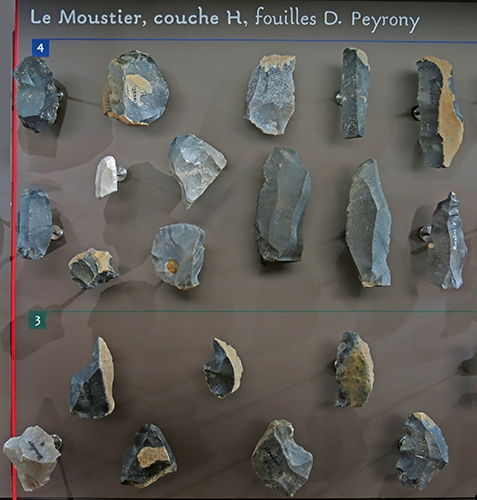
Le Moustier, layer H, excavations of D. Peyrony.
Age circa 55 000 BP.
■ 3 Encoches/denticulés, notched/serrated tools
■ 4 Tools of the upper Palaeolithic type
Photo: Don Hitchcock 2014
Source: Originals, Le Musée National de Préhistoire, Les Eyzies-de-Tayac
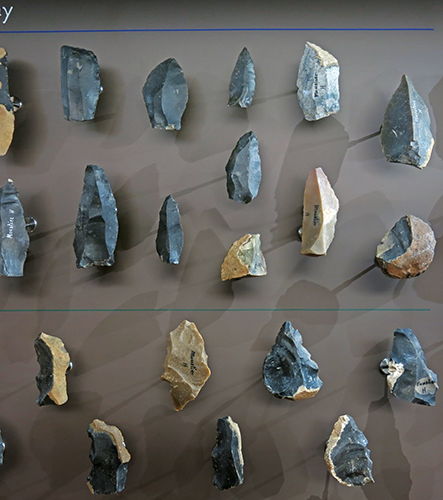
Le Moustier, layer H, excavations of D. Peyrony.
Age circa 55 000 BP.
■ 3 Encoches/denticulés, notched/serrated tools
■ 4 Tools of the upper Palaeolithic type
Photo: Don Hitchcock 2014
Source: Originals, Le Musée National de Préhistoire, Les Eyzies-de-Tayac
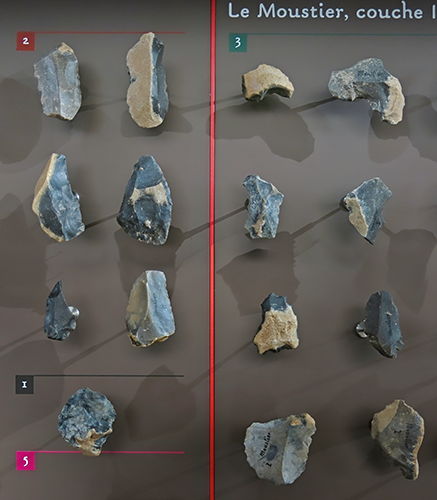
(left) Le Moustier, layer H, excavations of D. Peyrony.
(right) Le Moustier, layer I, excavations of D. Peyrony.
Ages circa 55 000 BP, 50 000 BP respectively.
■1 Bifaces, hand axes
■ 2 Racloirs, side scrapers
■ 3 Encoches/denticulés, notched/serrated tools
■ 5 Special tools
Photo: Don Hitchcock 2014
Source: Originals, Le Musée National de Préhistoire, Les Eyzies-de-Tayac

Le Moustier, layer I, excavations of D. Peyrony.
Age circa 50 000 BP.
■ 3 Encoches/denticulés, notched/serrated tools
Photo: Don Hitchcock 2014
Source: Originals, Le Musée National de Préhistoire, Les Eyzies-de-Tayac
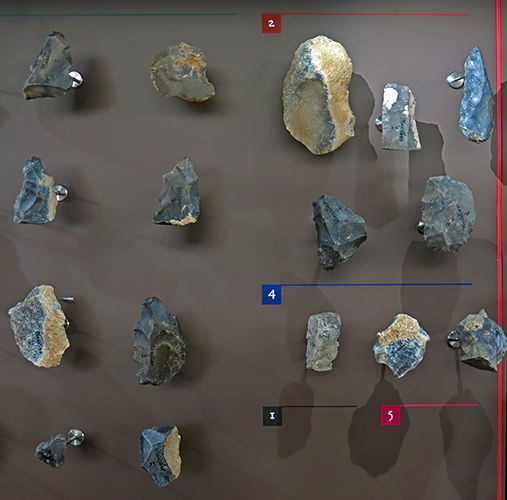
Le Moustier, layer I, excavations of D. Peyrony.
Age circa 50 000 BP.
■1 Bifaces, hand axes
■ 2 Racloirs, side scrapers
■ 3 Encoches/denticulés, notched/serrated tools
■ 4 Tools of the upper Palaeolithic type
■ 5 Special tools
Photo: Don Hitchcock 2014
Source: Originals, Le Musée National de Préhistoire, Les Eyzies-de-Tayac
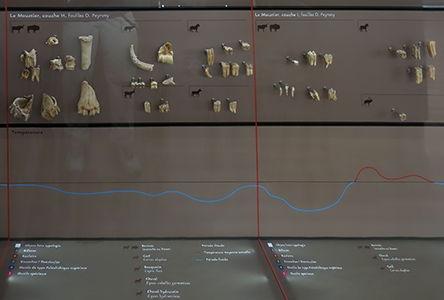
Bones and other organic remains from le Moustier, layers H and I, excavations of D. Peyrony.
Photo: Don Hitchcock 2014
Source: Originals, Le Musée National de Préhistoire, Les Eyzies-de-Tayac
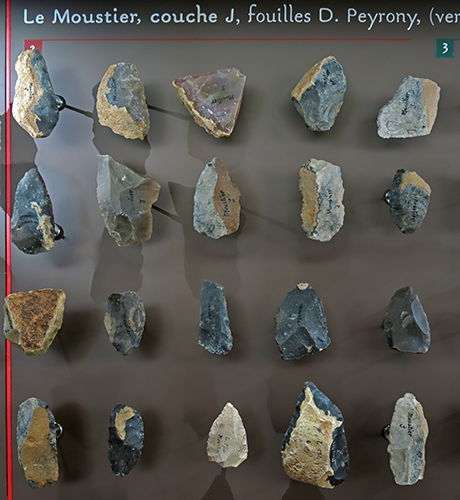
Le Moustier, layer J, excavations of D. Peyrony.
Age circa 40 500 BP.
■ 2 Racloirs, side scrapers
■ 3 Encoches/denticulés, notched/serrated tools
Photo: Don Hitchcock 2014
Source: Originals, Le Musée National de Préhistoire, Les Eyzies-de-Tayac

Le Moustier, layer J, excavations of D. Peyrony.
Age circa 40 500 BP.
■ 3 Encoches/denticulés, notched/serrated tools
Photo: Don Hitchcock 2014
Source: Originals, Le Musée National de Préhistoire, Les Eyzies-de-Tayac
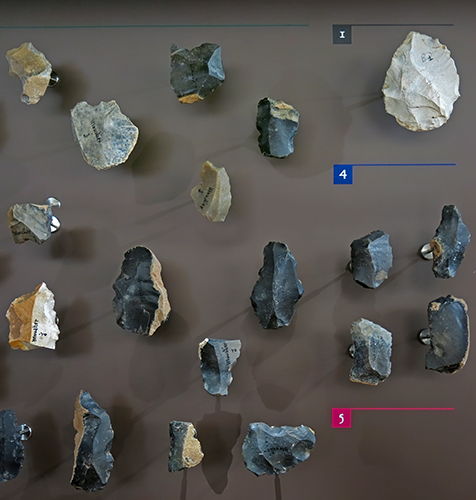
Le Moustier, layer J, excavations of D. Peyrony.
Age circa 40 500 BP.
■1 Bifaces, hand axes
■ 3 Encoches/denticulés, notched/serrated tools
■ 4 Tools of the upper Palaeolithic type
■ 5 Special tools
Photo: Don Hitchcock 2014
Source: Originals, Le Musée National de Préhistoire, Les Eyzies-de-Tayac

Bones and other organic remains from le Moustier, layer J, excavations of D. Peyrony.
Note that the age given here for layer J, circa 45 000 BP, is at variance with that given on the display immediately above of the stone tools, circa 40 500 BP.
Photo: Don Hitchcock 2014
Source: Originals, Le Musée National de Préhistoire, Les Eyzies-de-Tayac
( Note that the upper, larger flake has apparently been made using the Levallois technique but in the form of a handaxe with one face mostly smooth and unworked after being struck from a carefully prepared core, while the lower, smaller flake has been made from a thick flake, or from a core, with the handaxe in the form of a biface, with both sides skilfully worked, in the technique known as MTA, or Le Moustérien de tradition acheuléenne - Don )
Figs. 1 a, 1 b, I c. Large broad flake, worked into a lanceolate form by careful chipping along the edges of the outer face.
Dark-grey flint, slightly glazed. Lightly weathered by surface-change on the face 1 b.
Length 122 mm, breadth 60 mm, thickness 18 mm.
Le Moustier.
Figs. 2 a, 2b, 2c. Implement of ovato-lanceolate form, almost equally convex on each face; the narrow or pointed end considerably thinner than the broad end or butt.
This specimen has been roughly chipped from the solid, and then more
carefully worked on the edges of the pointed end, thus resembling some of the old worked flints from the Valley of the Somme.
A small portion of the original crust of the flint is left on the outer curve of Fig. 2 b.
Dark-grey flint, slightly glazed.
Length 90 mm, breadth 57 mm, thickness 30 mm.
Le Moustier.
Source and text: Lartet and Christy (1875)
Proximal source: https://archive.org/
These specimens belong to the type of implement specially adapted for being held in the hand by the thick and naturally rounded margin; whilst the opposite margin, reduced to a sharp curved edge by careful chipping, can be used as a hatchet or chopper, and seems well fitted for smashing the marrow-bones which are found broken among the hearth-stuff of the caves in great profusion.
These choppers vary much in size, and were chiefly found in Le Moustier Cave, a few only having occurred at Les Eyzies or elsewhere. Many seem to show signs of wear; and some have the edge chipped at a much more obtuse angle than others.
1. One-edged cutting-instrument, or chopper, formed from a block of grey flint, which has been first reduced by bold chipping to a flattened form, and then finely chipped on both faces along one margin, so as to produce a sharp cutting edge in the form of a segment of a circle.
The other margin is left with the natural crust
of the flint, and can be conveniently held in the hand. On the side figured, a portion of the crust remains, the rest of the surface having been chipped away.
From Le Moustier.
Length 130 mm, breadth 88 mm, thickness 32 mm.
2a, 2b. A similar instrument, but bevel-edged, formed of a large thick flake, that has been struck off at a single blow from a block of flint, and then brought to a curved cutting-edge along one border by the chipping away of the outer face.
This flint is nearly black, with a yellowish crust remaining on the portion that is convenient for holding in the hand.
2a shows the chipped side, with some of the crust remaining; fig. 2b, the flat side.
From Le Moustier.
Length 95 mm, breadth 74 mm, thickness 21 mm.
Source and text: Lartet and Christy (1875)
Proximal source: https://archive.org/
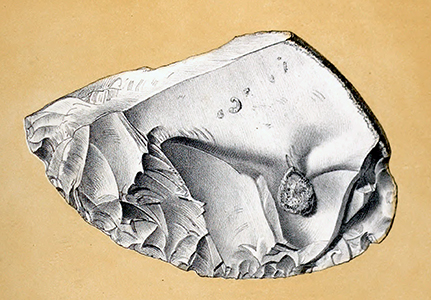
Figure 3, Plate XXXVIII
Brownish grey, subtriangular. The back is awkward for handling, possibly from inadvertent fracture.
Length 140 mm, breadth 98 mm, thickness 33 mm.
Source and text: Lartet and Christy (1875), Figure 3, Plate XXXVIII
Proximal source: https://archive.org/
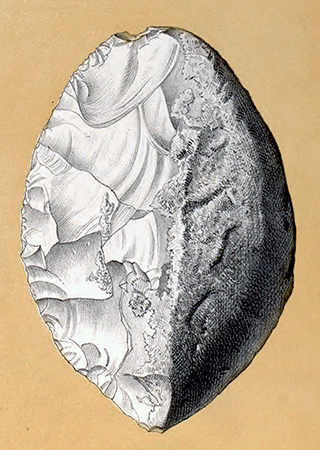
Figure 6, Plate XXXVIII
Brownish grey, acute-ovate, carefully dressed, so that the elliptical curve of the cutting edge corresponds with that of the natural portion of the flint nodule, which remains as the back of the implement, fitting easily into the hand.
Length 119 mm, breadth 82 mm, thickness 49 mm.
Source and text: Lartet and Christy (1875), Figure 6, Plate XXXVIII
Proximal source: https://archive.org/
Plate XL
Moustier Cave.
General notes on Figs 1 to 4:
Fig.1 is a ridge-flake, pointed at one end by dressing and wear as a scraping and boring tool.
Figures 2 and 3 are broad short flakes dressed to a triangular outline. The symmetrical point of fig. 2 is turned to the left hand upwards, and that of fig. 3 is turned to the right hand.
Figure 4 is more highly finished, dressed on both faces, biconvex, oval, and trenchant
( that is, having a sharp edge - Don )
along its whole margin. Larger tools of this style, but more lanceolate, and thicker at the butt, are characteristic of Le Moustier.
Specific notes:
Fig. 1. A mottled grey arched flake, pointed at one end; chipped on one edge, and retaining some of the original crust at the other. Length 106 mm, breadth 27 mm, thickness 11 mm.
Fig. 2. Mottled, dark-grey, broad flake, carefully dressed to a triangle, one point of which (to the left hand in the figure) is sharp and regular. Length 56 mm, breadth 60 mm, thickness 10 mm.
Fig. 3. Somewhat similar to fig. 2, but less symmetrical.
Length 65 mm, breadth 45 mm, thickness 15 mm.
Fig. 4. Brownish-grey, broad-oval, biconvex, sharp along the edge, and dressed on both faces. The notch is probably of recent origin. Length 50 mm, breadth 41 mm, thickness 13 mm.
Fig.5. Dark grey flake retaining a bulb of percussion, shaped by dressing on the
ridge side into a sharply pointed Lance-head (?), with thick butt. A patch of original crust remains on the convex face, and some tufaceous patches adhere to the other. Length 70 mm, breadth 50 mm, thickness 15 mm.
Fig. 6. Dark-grey, bulbed flake, shaped into a narrow lanceolate tool or weapon. A little of the crust still remains. Length 60 mm, breadth 27 mm, thickness 8 mm.
Fig. 7. Portion of a dark-grey flake, very neatly dressed. Some original crust remains at the greatest convexity.
Length 80 mm, breadth 35 mm, thickness 13 mm.
Source and text: Lartet and Christy (1875), Plate XL
Proximal source: https://archive.org/
References
- Capitan, L., 1915: Bulletin de la Société Préhistorique Française, 1915, pp 137 - 138
- Favraud, A.,1908/1909: La station Moustérienne du Petit-Puymoyen Alcan, F. (ed) Revue de L'École d'Anthropologie de Paris, 1908-1909 (not in copyright)
- Lartet, E., Christy H.,1875: Reliquiae aquitanicae : being contributions to the archaeology and palaeontology of Pèrigord and the adjoining provinces of Southern France, London: Williams, 1875
- Peyrony, D., 1930: Le Moustier. Ses gisements, ses industries, ses couches géologiques Revue anthropologique, XL, 1930, p49 - 52
Back to Don's Maps
 Back to Archaeological Sites
Back to Archaeological Sites
